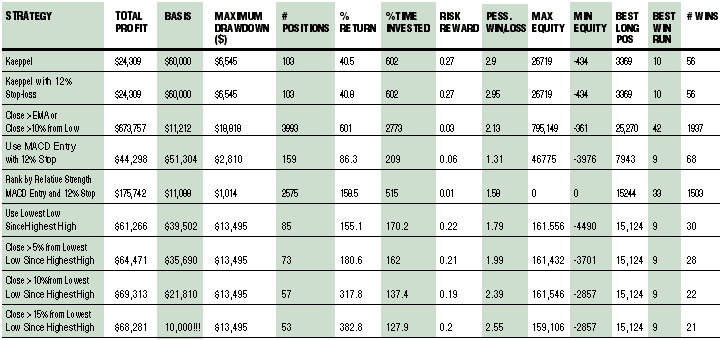TRADING TECHNIQUES
Improvements On A Strategy
Enhanced Fund Switching
by Jack Singer
Jay Kaeppel published a highly successful fund switching strategy in July 1999. Here's how to make it even juicier.
In March 1999, I lost a client to a stockbroker because I was too conservative in my investing style, using the accepted strategy of buy/hold on a diversified portfolio of funds. Asset allocation and diversification, for those who don't know, is where money is spread over a variety of assets, some of which will outperform and others of which will underperform. All are at various stages of cyclical performance, the underlying strategy being that over the long run, they will balance each other, and the average trend of the portfolio will be growth.

| DEFINITIONS: Total Profit Total of all profits from closed positions Basis The amount of capital required to execute all the trans- actions in the test Maximum Drawdown The largest of all position drawdowns #Positions Total number of positions taken during the test %Return Total profits times 100 divided by basis % Time Invested Percentage of time invested for the test. (Time invested / total time tested)*100 Risk/Rwrd Maximum drawdown divided by total profits |
Pess Win/Loss Pessimistic win/loss ratio. The larger this return, the better the strategy.(#wins-SQR(#wins))*AvgWin/ (#losses+SQR(#losses)*ABS(AvgLoss) Max Equity Largest profit from open positions at any time during the test Min Equity Largest loss from open positions at any time during the test Best Long Pos'n Profit from the best long trade Best Win Run Largest number of consecutive profitable positions during the test |
FIGURE 1: TEST RESULTS. Here are the results from various strategies that Singer tried. See definitions at the bottom of the figure for explanation.
However, on March 27, 1999, an article appeared in The Economist questioning the asset allocation theory. Jim McNulty and Max Ziff, two bankers at Warburg Dillon Read, had found that their clients believed that the capital asset pricing model (CAPM), the textbook standard, was no longer effective. They then asked the question, "Has theory lost touch with common sense?"
I perked up. If CAPM did not work, what did? The first hints of momentum investing were appearing in the news media with regard to daytrading. I started looking for an alternative investing strategy for funds.
When I ran across Jay Kaeppel's article in the July 1999 issue of STOCKS & COMMODITIES, I decided to run tests on his strategy using the internal relative strength of various Fidelity indices. I programmed the strategy into TechniFilter Plus, and after extensive testing, I decided that Kaeppel's method, although applied only to Fidelity stocks in the context of his article, could be used on the overall fund market. (See this issue's Traders' Tips for the TechniFilter Plus code.) It was also the investment style of momentum investing that I had been looking for.
Jack Singer is a Vancouver, Canada based money manager. He can be reached at jasin@home.com.
Excerpted from an article originally published in the October 2000 issue of Technical Analysis of STOCKS & COMMODITIES magazine. All rights reserved. © Copyright 2000, Technical Analysis, Inc.
Return to October 2000 Contents